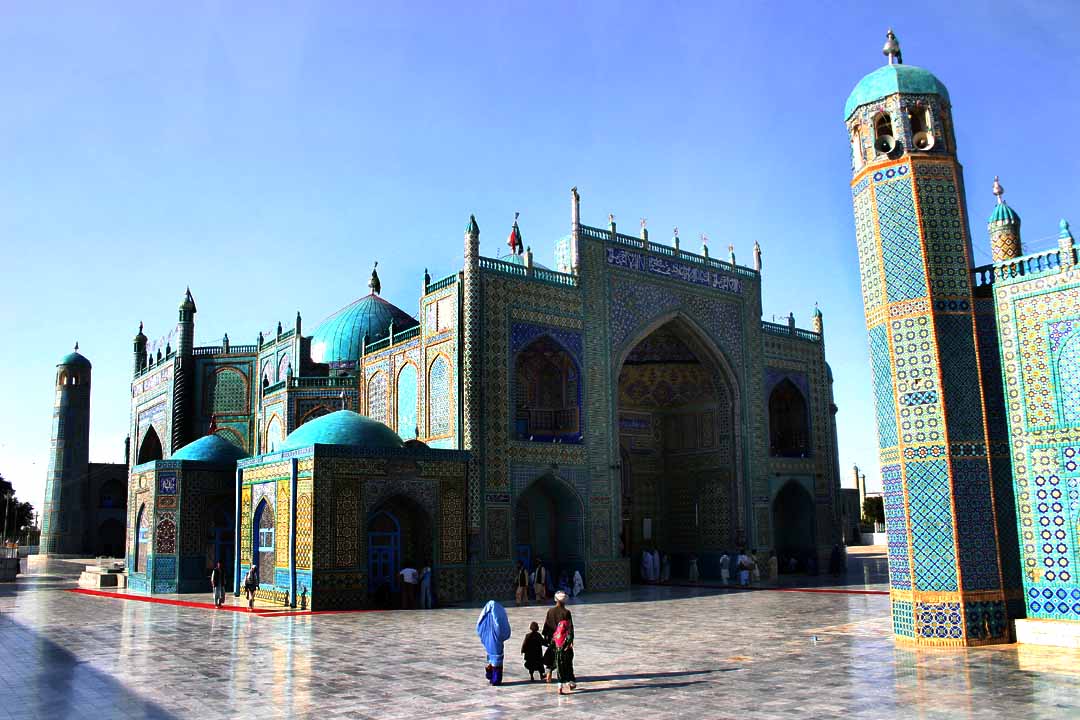- Shrine of Hazrat Ali
Infobox religious building
building_name = Shrine of Hazrat Ali
infobox_width =

image_size =300px
caption =
map_type =
map_size =
map_caption =
location =Mazari Sharif ,Afghanistan
geo =
latitude =
longitude =
religious_affiliation =Islam
rite =
province =
district =
consecration_year =
status =
functional_status =
heritage_designation =
leadership =
website =
architecture =
architect =
architecture_type =
architecture_style =
facade_direction =
groundbreaking =
year_completed =
construction_cost =
specifications =
capacity =
length =
width =
width_nave =
height_max =
dome_quantity =
dome_height_outer =
dome_height_inner =
dome_dia_outer =
dome_dia_inner =
minaret_quantity =
minaret_height =
spire_quantity =
spire_height =
materials =
nrhp =
added =
refnum =
designated =The Shrine of Hazrat Ali, also known as the Blue Mosque, is a mosque in
Mazari Sharif ,Afghanistan . It is one of the reputed burial places ofAli . It is the building which gives the city in which it is located,Mazari Sharif (meaning "Tomb of the Exalted") its name.cite book |last= |first= |authorlink= |coauthors= |editor=Girardet, Edward and Jonathan Walter, eds.|others= |title= Afghanistan|origdate= |origyear=1998 |origmonth= |url= |format= |accessdate= |accessyear= |accessmonth= |edition= |series= |volume= |date= |year= |month= |publisher= CROSSLINES Communications, Ltd. |location=Geneva |language= |isbn= |oclc= |doi= |id= |pages= 291|chapter= |chapterurl= |quote= ]According to Shi'a Muslim belief,
Ali was originally buried by his two sons, Hasan and Husayn in an undisclosed location, which was later made known by the great, grandson of Husayn and Sixth Shi'a Imam,Ja'far as-Sadiq - as the grave that is found withinImam Ali Mosque inNajaf ,Iraq . [Shaykh Al Mufid. "Kitab al Irshad", Translated by I.K.A Howard. pp.1-6]History of the Mosque
The story of the founding of the shrine indicates that, shortly after the murder of Ali and the burial of his body at Najaf, near
Baghdad , some of Ali's followers worried that his body would be desecrated by his enemies, and they placed his remains on a white female camel. Ali's followers traveled with the camel for several weeks, until the camel ultimately fell to the ground exhausted. The body was then reburied where the camel fell. The body was said to be redisovered there in the 12th century.The
Seljuq dynasty sultanAhmed Sanjar built the first shrine at this location. it was destroyed byGenghis Khan in the invasion around 1220. It was rebuilt in the 15th century by Husain Baiqara. cite web |url=http://archnet.org/library/sites/one-site.jsp?site_id=10561 |title= ArchNet|accessdate=2008-06-12 |publisher= |date= ] Most of the shrine's decorations, however, are the result of modern restoration work. One of the few remaining artifacts from the earlier shrine is a marble slab inscribed with the words, "Ali, Lion of God."A site plan of the location made in the 1910s shows that there had earlier been a smaller walled precinct in the mosque, which were razed to create parklands later, althoug the portals to this precincts still remain as gateways for the shrine.The core of the shrine contains Ali's tomb chamber and its ziaratkhana, which is an antechamber for prayer and worship. Tombs of varying dimensions were added for a number of Afghan political and religious leaders over the years, which has led to the development of its current irregular dimensions. These include the square domed tomb of Amir Dost Muhammad and a similar structure for Amir Sher Ali and his family.
References
Wikimedia Foundation. 2010.
